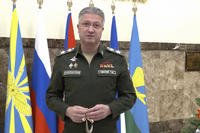Marine Corps Commandant Gen. James Amos didn't mince words describing his commitment to the Amphibious Combat Vehicle and delivering the Corps a new amphibious tractor when speaking with reporters at the Pentagon Thursday.
"We need an amphibious tractor, period," Amos said.
The Marine Corps four-star expects his acquisition team to finish the requirements for the ACV this fall and potentially submit a request for proposals to the defense industry. Amos read over the completed Analysis of Alternatives in June and remains optimistic the Corps will get its tractor. He received additional briefs on the ACV this week.
"We're going to get one opportunity to do this right," Amos said. "I want to make sure when we go to Congress with the requirement that Congress looks at it and says it makes complete sense to me and I fully support it. I feel like we are right where we need to be."
Amos is understandably feeling pressure to deliver the Corps a new amphibious tractor. Their last attempt, the Expeditionary Fighting Vehicle, was notably canceled by former Defense Secretary Robert Gates as requirements spiraled and questions arose about just how far a Marine squad could travel from ship to shore.
The Marine Corps has its top scientists and engineers evaluating the ACV's requirement's down in Woodbridge, Va., and making decisions on cost tradeoffs to keep the tractor affordable, Amos said. A major issue remains the distance the tractor will have to travel ship to shore and whether it can get up on plane and travel over the waves.
If the transport doesn't reach the necessary planing speed, then the Marines aboard must endure the choppy surf and the slow pace will make them a fatter target. However, with the additional speed comes a higher price tag.
"[The scientists] have been getting into the physics of fluid dynamics. How fast a vehicle can go before you have to have a planing vehicle. How big a motor you have to have. What's the cost tradeoffs. They've been working on that for a little over a year-and-a-half," Amos said.
Following the completion of the AOA, Amos said he wants his acquisition team to work with the engineers and re-evaluate the requirements one last time to make sure the requirements are "locked in concrete."
He made sure to not make the same mistakes the Corps made with the EFV. Amos emphasized that the Corps is not interested in building a luxury tractor, he wants a fighting vehicle that can deliver a squad of Marines ashore for amphibious assaults.
"This is not a Cadillac Escalade we're trying to build here," Amos said. "This is a fighting vehicle that will come ship to shore and go in with likely a squad of Marines. We are trying to make sure we are not building something that ends up with capabilities that we don't need or can't afford."








